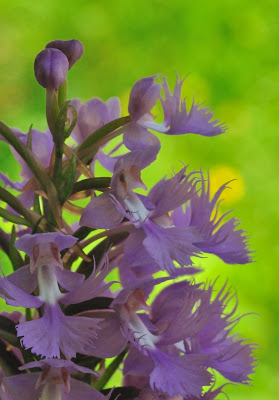Since spring is here, some tips on the art of wildflower photography might be appropriate. Let me begin by saying that I am only expressing my opinions about the subject. In my view, the qualities of a good wildflower photograph are those that: exalt the beauty, uniqueness, and character of a wildflower as seen and felt by the photographer in its natural setting. Delving deeper into the art of wildflower photography, I believe a good image employs the wildflower as a means of evoking emotions, provoking thoughts, and inviting the observer to explore the nature of self and the world. In this blog, I would like to share eight images that illustrate my approach to the art of wildflower photography.
 |
Purple Fringed Orchid
|
Focus on the unique:
This image of a purple-fringed orchid highlights the intricate fringes of the orchid. By taking a profile view of the flower head and by eliminating any background detail that would distract or obscure the blossom, the fine structure of the fringes are highlighted. On a deeper level, to me, the flowers resemble angels with out-stretched wings.
 |
| White Avens |
Negative Space:
In this image, a lone white avens sits by itself on a stem. When photographing a flower, it�s common to fill up the entire frame with the subject. But negative space, the area between and around the subject, often puts not less but more emphasis on the subject. In addition, the negative space assumes its own meaning. The image suggests that the flower is reaching out into a nebulous void in search of something enigmatic.
 |
| Wild Columbine |
Concentrate on the Bokeh:
Bokeh (pronounced Bough-kay) is a Japanese term for the subjective aesthetic quality of out-of-focus areas of a photographic image. Simply put, it is �the background blur.� Bokeh is a powerful tool that can richly add meaning to a wildflower image. This is an image of a wild columbine. They are by nature a very showy flower and can grow prolifically. In a patch of wild columbine, all the blossoms seem to shout for attention. I lined up the background and adjusted the blur, the bokeh, in this image to showcase the bloom�to let it �show-off.�
Leave Areas Out of Focus:
It seems counter-intuitive not to put an entire flower blossom into clear focus. Yet, leaving part of the blossom softly out of focus has a strong artistic effect. On one hand, the portion of the flower that is in focus catches the eye and becomes the center of attention. Meanwhile the soft focus region instills depth to the image, creating, in effect, a three-dimensional feel.
 |
| Turk's Cap Lily |
Black Backgrounds:
A colorful flower, such as this turk�s-cap lily, set against a black background almost always produces a stunning image. In the studio, background color is easy to control. In the wild, it takes more thought and technique. To achieve a black background in the field, I lined up the shot so the flower was set in front of the darkest background I could find. Then I set my light meter on spot metering and centered it on the flower blossom. In full sun, the showy flower was the brightest subject. My camera automatically lowered the exposure level of the whole image, so the bright blossom was not over exposed while darkening the background.
 |
| Tall Ironweed |
Maximize the Macro:
Macro settings and lenses allow for extreme close-ups, which enlarge the minute details of a wildflower bloom. The tall ironweed pictured here stood alone in a large field. A photograph of the whole plant or even the entire blossom head might not have been very interesting. But the macro lens image highlighted the fascinating and intricate flower structure. Frankly, I had not realized before the beauty inherent in the complex design of the ironweed wildflower. Although macro photography can be revealing, it can also be overdone. In my opinion, wildflower photography is not primarily an exercise in macro photography.
 |
| Showy Sunflowers |
Include Context:
A macro of one of these showy sunflowers might have made a good image. But wildflower photography is naturally done in the wild. Capturing where wildflowers live, their context so to speak, is important to me. So I chose to put the lead flower in focus and let the others illustrate the beauty of the whole stand of flowers.
 |
| Deptford Pink |
Combine Ideas:
The blossom in this image is a deptford pink, which is no larger than the tip of your little finger. Yet, the fine detail of the flower is amazing. In this image I tried to apply multiple ideas to bring out the best of this small wonder. I used a macro lens to capture the fine detail of the flower. But I gave the blossom some negative space to showcase its angular, grass-like structure. And I employed the bokeh by varying the patches of background color. The light yellow on the right profiles the newly forming bud while the green on the left makes the pink flower stand out.











Comments
Post a Comment